Amos P. Kennedy, Jr.’s bold prints, posters, and books
From Amos P. Kennedy Jr.’s Mask Book. Said Kennedy, “The book is an early experiment in layering text. All the layers relate to the mask.”
If you think letterpress printing has been relegated exclusively to the domain of typophiles and aesthetes, welcome to the world of Amos P. Kennedy, Jr.: “Humble negro printer.” His choice of that title reflects a commitment to social activism that manifests on broadsides, in books, and now in a documentary film titled Proceed and Be Bold.
It’s nearly impossible to catch up with him unless he comes to a town near you. One day he is opening an exhibition in Chicago, another he’ll be conducting a workshop in Wisconsin, New York, or Italy. On August 25, you can find him in Burkville, Alabama, hawking letterpress broadsides at the Okra Festival. We recently spent some time together in a Skype video chat.
RM: What was it about letterpress printing that first attracted you?
AK: The impression of the type on the paper. I was watching a demonstration of Colonial printing in Williamsburg, Virginia, in 1988. When he pulled the impression, that was fascinating.
RM: At what point did you decide to give up a successful career in computer programming and devote yourself to mastering this arcane craft?
AK: Pam Barry was teaching a book arts class at Artists Book Works in Chicago. I took two classes there, became an advanced member, and could come after hours. I printed there another six months, and then got a free Vandercook 4. Moved it into my basement in Oak Park, under the staircase to what used to be the coal room. A couple of weeks later, Pam, another printing student named Mary Kennedy, and I went to a swap meet of the Midwest Amateur Printers Association. One of the members told me he had a 30 pica, 1-line job stick if I wanted to stop by his place and pick it up. I did, and as I was leaving he pointed to a wall with four type cabinets full of beautiful foundry type and asked me if I would like to have them. That’s when my life changed, and I became a printer.
all images Courtesy of Amos P. Kennedy Jr.
I started printing broadsides of poems, primarily by black poets, and passing them out on the El on the way to and from work—Langston Hughes, Georgia Douglass Johnson, James Weldon Johnson, Countee Cullen, Paul Laurence Dunbar—people like that. In 1989 I quit my job as a computer programmer.
RM: How many books did you make before switching to broadsides as your primary medium? What are your three favorites of those books and what are your three favorite broadsides?
AK: I made about twenty books until 1998, smaller books in editions of ten or fifteen, and gave them away. Favorites? Strange Fruit, the big Mask Book, and the little Snake Book in the form of a necklace. I made twenty-five or thirty of those and gave them away—might’ve sold one or two.
As for broadsides, I did a series in 1992 and 1993 on the murdered children in Chicago. One for each child that was murdered. Sixty broadsides. Kroch’s & Brentano’s bookstore in Chicago, which had a great art section, gave me a large space, and I put all sixty on the wall. Articles had appeared in the newspapers when each child was murdered, but people were shocked when they saw the wall with all of them together. It made them realize it was an epidemic.
I like doing series that are all related, like the Rosa Parks series—fourteen of her quotes, each on a chipboard poster. Those were sold individually, but I also printed an edition on Hahnemühle paper that is only sold in sets. But it’s not just about the individual posters. I’m waiting for someone to understand that two thousand posters on the wall are one art piece, one statement.
RM: You balance on a thin edge between identifying yourself as an “artist” or not. What’s that about?
AK: This is a real tough subject for me, because the term “artist” has been co-opted by a set of people who want to exclude 99.9 percent of “theseunitedstatesofamerica.” I think that if you have to make an “artist statement,” you’re not making art, you’re making statements. I think art is the activity of creating things of beauty. One artist said you need to have a philosophy behind your art. I have a philosophical basis for my work—the gas bill, the electric bill, the rent….
I believe art should be available to all human beings, and make it so a ten-year-old can buy it. It’s an entry point for art. These $10–$15 posters are sometimes the first art they ever got that was made by a human being they can talk to. They learn what printmaking is about, and sometimes go on to build a collection.
RM: In the documentary Proceed and Be Bold, you are first presented as someone who gave up family and lifestyle for your passion, but the end of the movie presents you as a man who has not made sacrifices, because you love what you do. Was there a turning point for you?
AK: I didn’t see a sacrifice when I gave up a middle-class lifestyle for printing—the sacrifice was living the middle-class lifestyle. The true sacrifice would have been not to print.
RM: What are you working on now?
AK: One reason I took off with posters is that I like the layered look that I can get with a poster, where the underlayers build up meaning under the text. People have to look at the sheet many times to get the information from all the layers, and if it’s up on the wall they see it over and over. This year I’m working on the transition of this layered approach to a book. The first version will be putting a series of layered posters together in a bound book, as I did with Strange Fruit. The tentative title is I am the Darker Brother. I cut the image out of masonite. Then, using the Werkman technique, I put the paper on the press bed and place the inked masonite down on the paper and run the cylinder over it.
I have another book in the works on coffee—it was a little subtle, so I’m adding overtly political content in layers about the coffee industry.
And I’m doing a series of books called the Alabama Photo Book Project with Alabama photographers. These are little eight-page pamphlets where I solicit thirty to fifty photos from each photographer. I make an edition with a title page, a quote, a page with one of the photos tipped in, and a colophon. Half the edition goes to the photographer and half I keep. I’ve done about thirty of these so far, all from handset type on Hahnemühle paper.





















